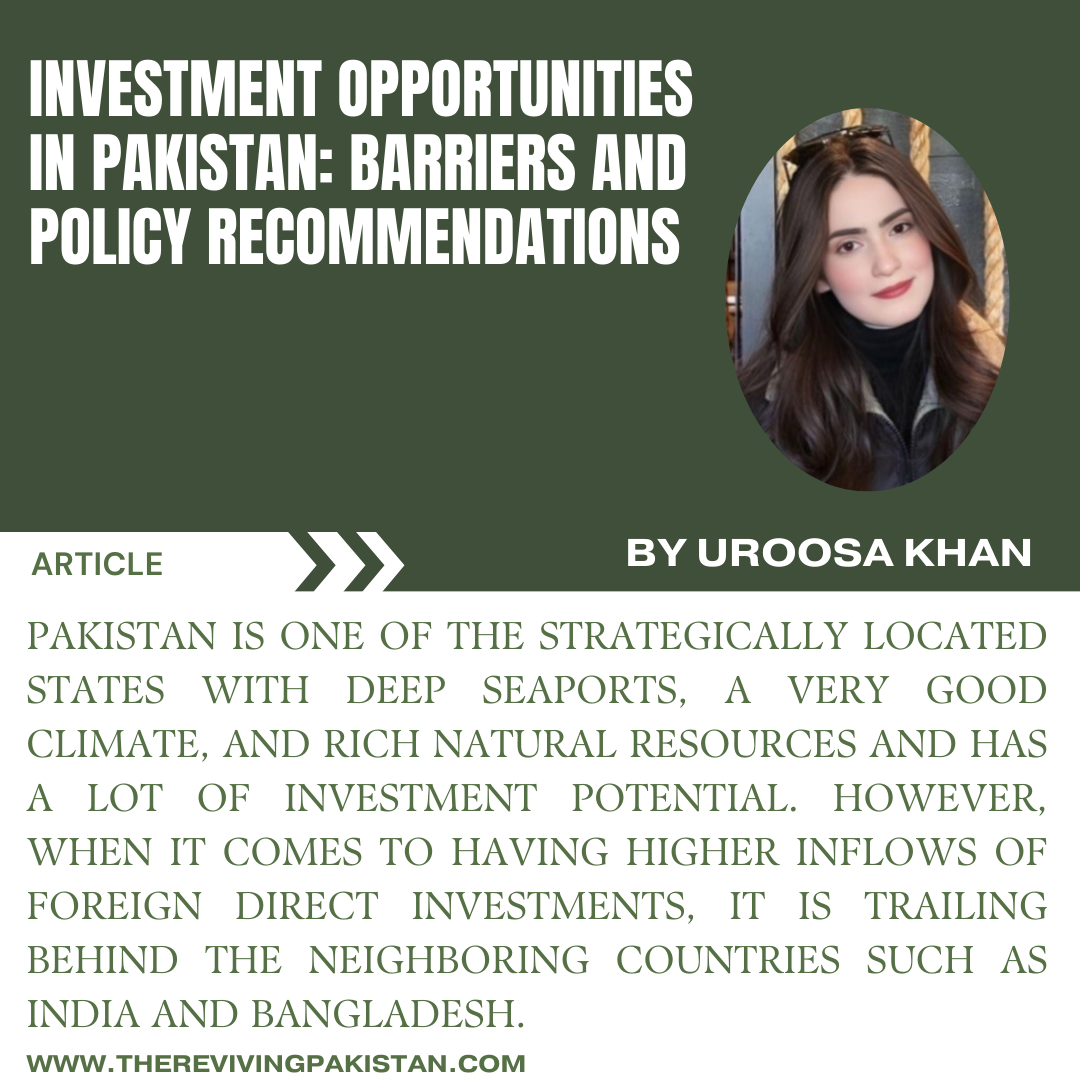About the Author(s)

Uroosa Khan
The author is a research analyst with a keen interest in foreign policy, history, geopolitics, and international relations.
Pakistan is one of the strategically located states with deep seaports, a very good climate, rich natural resources and has a lot of investment potential. However, when it comes to having higher inflows of foreign direct investments, it is trailing behind the neighbouring countries such as India and Bangladesh. India was marketed as a destination for business and Bangladesh has proved to show remarkable economic growth, whereas Pakistan is much behind in reaping such confidence from the investors.
The article shows why all the inherent strengths of Pakistan could not yet make it an attractive place for investment, and how it requires some policy change in improving its investment climate. The first and foremost reason behind Pakistan’s failure was that of undeterred persistent political instability coupled with bad governance. Successive governments might not complete their tenures; and because policy keeps changing, investors can rarely predict what will come the next day. Since most long-term investments have long gestation periods and therefore require a high level of confidence that regulations or incentives won’t change abruptly, such investments are rather elusive. Weak governance structures as well as the lack of any effective checks and balances make economic growth difficult. Inconsistent policies and weak implementation discourage foreign companies to enter or expand in Pakistan.
Other security concerns make the issues even worse for foreign firms. Despite internal security advances, insecurity is at the top of investor lists. The fears about terrorism and regional conflicts create anxiety amongst investors who may shift investment to more secure regions of India or South Asia which are perceived by the business community to pose a threat of security risks low in value. These safety issues result in an opinion regarding Pakistan as a high-risk country for foreign investment. Due to this reason, companies avoid themselves trying out the business opportunities available in Pakistan.
Bureaucratic red tape and complex regulation are also inhibitors. Inefficiency is often marred by bureaucracy in Pakistan, coupled with excessive documentation and slow clearance, providing serious hurdles both for homegrown and international businesses alike. Long-drawn processes and complex regulations increase the time and costs attached to putting up or increasing operations. Moreover, an environment brought about by bureaucratic hurdles more often than not encourages corruption, as a company strives to circumvent long procedures, which chases off genuine investors.
Inadequate infrastructure and power shortages pose other important issues for the country. Pakistan remains at the developing stage; thus, the country’s transport and energy infrastructures lag far behind their competitors in the region. These pose a big problem in industries running their activities, mainly due to constant electricity breaks and very costly energy sources, thus not really appealing to foreign investors in the Pakistani market. The nations of India and China invested massively in infrastructure and established good systems to support industry and commerce. On the other hand, Pakistan must build the most stable infrastructure network it can to be able to stand in the international field for investment.
Furthermore, the availability of financial access is also somewhat scarce, and high interest rates have been set such that could not aid the indigenous private sector increase and introducing innovative products. The country’s financial sector is undeveloped, and cheaper credits are not in hand. In reality, the lack of readily available funding is a peculiar challenge to small and medium-sized enterprises (SMEs), which constitute an economic backbone for diversification and growth. High interest rates and inflation make borrowing very expensive, thus reducing a firm’s ability to invest in expansion or modernization. It discourages further the would-be foreign investors who have the potential to venture into a market whose constraints do not allow its prospects to grow.
There have been some good steps taken recently towards attracting foreign investment. Setting up the Special Investment Facilitation Council is one positive development that focuses on the attraction of capital from Gulf countries into areas like agriculture, technology, and manufacturing. Civil-military cooperation gives foreign investors more confidence, as historically, Pakistan’s military institutions were more trusted than the civilian government. With the assistance of SIFC, Pakistan has signed more than 30 MoUs with Saudi Arabia, which would inject billions of dollars into the economy. Further examples are Prime Minister Shehbaz Sharif’s visit to Qatar, which exemplifies Pakistan’s quest to obtain investment from a broad pool of sources. Yet the potential of such efforts could only be translated into actuality when the government takes measures towards dealing with the very core causes that scare investors.
Transformation into more of an investment-friendly destination for Pakistan would require policy reforms in the following measures.
Political stability and continuance of policy. This is a necessary condition when long-term policies are undertaken that stretch further than individual governments and make people confident. Major projects by an independent economic body having consistency in the policies given could provide investors with just the stability required. The second would be that economic policies of any government will be ensured by cross-party consensus and there will not be a sudden shift in government policy. Finally, for investors and for economic growth, the governance structure should be transparent and accountable with proper check and balance mechanisms.
Improvement in security is pertinent. In fact, as a follow-up to the latest successes in the fight against terrorism, securing business regions and surrounding areas of the industrial centres would enhance the prestige of the government and safeguard the interests of the safety of the investors. Public-private security infrastructure partnerships would work toward making safer environments around the hubs, especially to assure foreign investors about investment in that region. This assurance would be provided when safe investor-friendly zones establish the fact that safety is dealt with effectively.
Another crucial reform is streamlining bureaucratic processes to create a business-friendly regulatory environment. Simplifying procedures, red tape reduction and digitization of government services would ease a lot of business operations. There could be a “one-window” facility for investors with centralization of permits and approvals that would otherwise result in lengthy documentation procedures. Anti-corruption measures within the bureaucracy, including transparency in approvals and the penalty for misconduct, will improve efficiency and reduce corrupt opportunities, making Pakistan a more attractive investment location.
Infrastructure investments and the resolution of the energy crisis are also critical. Pakistan requires heavy investment in energy and transport to enhance the competitiveness of its industry. Public-private partnerships could be critical in bridging infrastructural gaps, whereas renewable energy initiatives would decrease dependence on expensive imports. Confident building of investors through assured consistent energy supply and improvement in infrastructural facilities would propel sustainable economic growth.
Equally important is access to finance by local businesses. Increased access to credit by SMEs, venture capital, and low-interest loans will be instrumental in achieving economic growth and innovation. The decline in the rate of interest along with bringing inflation under control will encourage borrowing, thus uplifting the potential of domestic businesses to grow and attract foreign investors. Economic policy reforms that enhance growth in domestic businesses also enhance Pakistan’s desirability as an investment destination since they show strength and activity in the private sector.
Developing special economic zones and industrial parks would further be taken as a step towards making an investor-friendly environment, which will provide various tax incentives and relaxed laws for specific industries such as manufacturing and information technology. The simplified tax regime will also ease the regulatory burden of businesses, and that would make Pakistan an easier choice for companies that might look to expand their wings across South Asia.
While the recent steps taken by the SIFC in Pakistan do provide a promising turnaround in revamping the investment landscape, the long-term interest of investors will not be established unless the fundamentals of these structural issues are addressed. With an ideal location, rich natural resources, and an ambitious investment framework, the potential for significant foreign investments in Pakistan, leading to economic resilience and job opportunities, is high. The pillars of such a competitive investment landscape are strong governance, political stability, simplified processes, and investments in infrastructure.
Pakistan has enormous potential for attracting foreign investment, but huge challenges exist that are causing it to lag behind the growth of a regional economic hub. The challenges should be met with a prolonged, multi-dimensional policy approach with the building of investor confidence and creating a stable, secure, and efficient business environment. Political stability streamlined regulatory processes, infrastructural improvement, and greater access to finance can bring a robust environment for foreign investment in Pakistan. With public-private partnerships, a strong commitment to governance reform, and long-term policies in place, the future of the investment landscape of Pakistan lies in being transformed to serve as the guarantee for long-term economic growth and stability.

